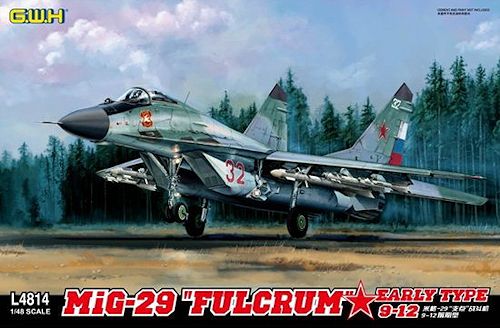
| KIT #: | L48014 |
| PRICE: | $102.00 SRP |
| DECALS: | Three options |
| REVIEWER: | Scott Van Aken |
| NOTES: |

| HISTORY |
The history of the MiG-29, like that of the larger Sukhoi Su-27 'Flanker', started in 1969 when the Soviet Union learned of the U.S. Air Force’s 'FX' program, which resulted in the F-15 Eagle. The Soviet leadership soon realized that the new American fighter would represent a serious technological advantage over all existing Soviet fighters. The MiG-21 'Fishbed' was agile by the standards of its day, but had deficiencies in range, armament, and growth potential. The MiG-23 'Flogger', developed to match the F-4 Phantom II, was fast and had more space for fuel and equipment, but lacked in maneuverability and dogfighting ability. What was needed was a better-balanced fighter with both good agility and sophisticated systems. In response, the Soviet General Staff issued a requirement for a Perspektivnyi Frontovoi Istrebitel (PFI, roughly "Advanced Frontline Fighter", directly "Perspective Forward Fighter"). Specifications were extremely ambitious, calling for long range, good short-field performance (including the ability to use austere runways), excellent agility, Mach 2+ speed, and heavy armament. The aerodynamic design for the new aircraft was largely carried out by TsAGI, the Russian aerodynamics institute, in collaboration with the Sukhoi design bureau.
However, in 1971 the Soviets determined that the PFI aircraft would be too expensive to procure in the quantities needed, and divided the requirement into the TPFI (Tyazholyi Perspektivnyi Frontovoi Istrebitel, "Heavy Advanced Tactical Fighter") and the LPFI (Legkiy Perspektivnyi Frontovoi Istrebitel, "Lightweight Advanced Tactical Fighter") programs, the latter paralleling the contemporary USAF decision that led to the "Lightweight Fighter" program and the F-16 Fighting Falcon and YF-17 Cobra. The heavy fighter remained with Sukhoi, resulting in the Su-27 'Flanker', while the lightweight fighter went to Mikoyan. Detailed design work on the resultant Product 9, designated MiG-29A, began in 1974, with the first flight taking place on October 6, 1977. The pre-production aircraft was first spotted by United States reconnaissance satellites in November of that year; it was dubbed Ram-L because it was observed at the Zhukovsky flight test center near the town of Ramenskoye. Early Western speculations suggested that the Ram-L was very similar in appearance to the YF-17 Cobra and powered by afterburning Tumansky R-25 turbojets.
Despite program delays caused by the loss of two prototypes in engine-related accidents, the MiG-29B production version entered service in August 1983 at the Kubinka air base. State acceptance trials where completed in 1984, and deliveries began the same year to the Soviet Frontal Aviation. The workload split between TPFI and PFI became more apparent as the MiG-29 filtered into front-line service with the VVS in the mid-1980s. While the heavy, long range Su-27 was tasked with the more exotic and dangerous role of deep air-to-air sweeps of NATO high-value assets, the smaller MiG-29 directly replaced the MiG-23 in the frontal aviation role. The Fulcrum was positioned relatively close to the front lines, tasked with providing local air superiority to advancing Soviet motorized army units. Rugged landing gear and protective intake grates meant the MiG-29 could operate from the damaged or under-prepared airstrips Soviet war planners expected to encounter during a rapid armored advance. The Fulcrum was also tasked with escort duties for local strike and interdiction air packages, protecting vulnerable ground attack aircraft from NATO fighters such as the F-15 and F-16. Frontal aviation MiG-29s would ensure Soviet ground forces could operate under a safe air umbrella, moving forward with the troops as they advanced.
In the West, the new fighter was given the NATO reporting name "Fulcrum-A" because the pre-production MiG-29A, which should have logically received this designation, remained unknown in the West at that time. The MiG-29B was widely exported in downgraded versions known as MiG-29B 9-12A and MiG-29B 9-12B (for Warsaw Pact and non-Warsaw Pact nations, respectively), with less capable avionics and no capability for delivering nuclear weapons. Total production was about 840 aircraft. The MiG-29 was first publicly seen in the West during a visit to Finland in July 1986. Two were displayed at the Farnborough Air Show in Britain in September 1988. Western observers were impressed by its apparent capability and exceptional agility, but found fault with the excessive smoke generated by its Klimov powerplants.
MiG-29 export customers have included Algeria, Bangladesh, Bulgaria, Cuba, Czechoslovakia, Eritrea, East Germany, Hungary, India, Iran, Iraq, Malaysia, Myanmar, North Korea, Peru, Poland, Romania, Serbia, Slovakia, Syria, and Yemen. The ex-Soviet republics of Belarus, Kazakhstan, Moldova, Turkmenistan, Ukraine, and Uzbekistan were left with large numbers of aircraft after the disintegration of the Soviet Union; some remain in service, others were mothballed or — like the 34 aircraft originally held by Moldova — have been sold abroad.
| THE KIT |
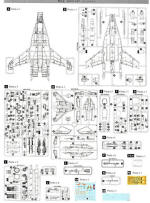 This
is the third MiG-29 kit to be released by GWH. It is not, of course, the only
one ever kitted, but may well be the best. There have been several
others, most notably by Monogram and by Academy. Those who are into the Fulcrum
can regale you with the seemingly long list of things wrong with those kits in
terms of shape. I am no major enthusiast of the MiG-29, but I would hope that
this one takes care of all those ills. I certainly was impressed when I opened
the box.
This
is the third MiG-29 kit to be released by GWH. It is not, of course, the only
one ever kitted, but may well be the best. There have been several
others, most notably by Monogram and by Academy. Those who are into the Fulcrum
can regale you with the seemingly long list of things wrong with those kits in
terms of shape. I am no major enthusiast of the MiG-29, but I would hope that
this one takes care of all those ills. I certainly was impressed when I opened
the box.
GWH has gone to considerable lengths to ensure that no parts are damaged during shipment. This includes having a tray inside the box. Atop this tray was the one-piece upper fuselage and wings. Under it were the rest of the parts. This includes the missiles being individually protected in plastic bubbles on a card. I do appreciate this and the fact that most of the missiles have all the fins as part of the missile. I truly dislike attaching multiple fins to these things!
I will
point out now that the canopy and windscreen have a seam running down the
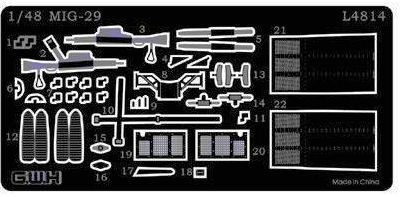 center
of them. This is required to get the proper 'bubble' shape as single molds will
not do undercuts. There is a photo etch fret for seat harness, gunsight, the
intake screens and the tiny vanes for one set of missiles, to name a few items.
The interior has ruder pedals, a nicely done seat and separate side
consoles. The consoles and instrument panel have raised detail and there are
individual instrument decals for the main panel.
center
of them. This is required to get the proper 'bubble' shape as single molds will
not do undercuts. There is a photo etch fret for seat harness, gunsight, the
intake screens and the tiny vanes for one set of missiles, to name a few items.
The interior has ruder pedals, a nicely done seat and separate side
consoles. The consoles and instrument panel have raised detail and there are
individual instrument decals for the main panel.
Many of you know that the MiG-29 has intake doors for ground operation. There are upper louvers to let in engine air. The kit offers the option to have these doors and louvers 'up or down' to duplicate engine operation with the intake guards in place or in a static condition. Having these up will allow you to see the engine compressors if the doors are not in place. GWH provides two complete engines and they install from the underside, just as on the real aircraft. A maintenance stand is also provided to show off one of the engines. As there are those of us who will not want to show off full engines, I was hoping there was an option to just install the rear compressor section, tail pipes and burner cans, but did not see one.
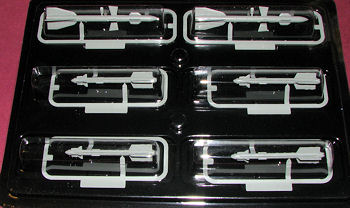 Other options
are for an open or closed canopy and an open or closed rear speedbrake. The kit
can also be built with the gear up if one wishes, but without a stand, most will
probably model it on the ground. The kit comes with a full load-out of six
missiles and pylons that includes
two R-27 'Alamo', and four R-73E 'Archer' missiles. Instead of the larger inner
missiles, a pair of drop tanks are available. A centerline tank is also part of
the mix. Holes in the wings need to be opened to provide attachment points for
the pylons.
Other options
are for an open or closed canopy and an open or closed rear speedbrake. The kit
can also be built with the gear up if one wishes, but without a stand, most will
probably model it on the ground. The kit comes with a full load-out of six
missiles and pylons that includes
two R-27 'Alamo', and four R-73E 'Archer' missiles. Instead of the larger inner
missiles, a pair of drop tanks are available. A centerline tank is also part of
the mix. Holes in the wings need to be opened to provide attachment points for
the pylons.
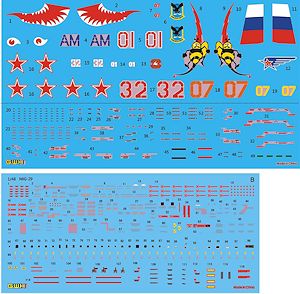 Markings are
supplied for three aircraft, all of them in Fulcrum Grey and Light Blue. Color
references are for Gunze and Vallejo paints. The options are the box art plane
for the 960 Fighter Regiment at Primorsk-Ahtarsk in
Markings are
supplied for three aircraft, all of them in Fulcrum Grey and Light Blue. Color
references are for Gunze and Vallejo paints. The options are the box art plane
for the 960 Fighter Regiment at Primorsk-Ahtarsk in
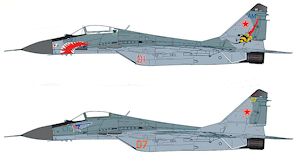 1997, a 968
Fighter Regiment aircraft based in East Germany during 1990, and a shark mouth
aircraft of the 152 Fighter Regiment in 1991. This unit is basically an
aggressor unit, hence the rather flamboyant markings.
Two sheets of
decals are provided. One is strictly stencils and is quite complete. Both are
very nicely printed and should prove to have no issues. There are also
aftermarket sheet for the other kits that should fit this one with few
alterations. The instructions are very well drawn and provide all the
information you will need to build the aircraft of your choice.
1997, a 968
Fighter Regiment aircraft based in East Germany during 1990, and a shark mouth
aircraft of the 152 Fighter Regiment in 1991. This unit is basically an
aggressor unit, hence the rather flamboyant markings.
Two sheets of
decals are provided. One is strictly stencils and is quite complete. Both are
very nicely printed and should prove to have no issues. There are also
aftermarket sheet for the other kits that should fit this one with few
alterations. The instructions are very well drawn and provide all the
information you will need to build the aircraft of your choice.
| CONCLUSIONS |
Nice to see that GWH is apparently covering all bases when it comes to the MiG-29. I anticipate the navalized version to show up in the near future.
| REFERENCES |
http://en.wikipedia.org/wiki/Mikoyan_MiG-29
March 2014
Thanks to www.dragonmodelsusa.com for the preview kit. This kit should be on your dealer's shelves.
If you would like your product reviewed fairly and fairly quickly, please contact the editor or see other details in the Note to Contributors.